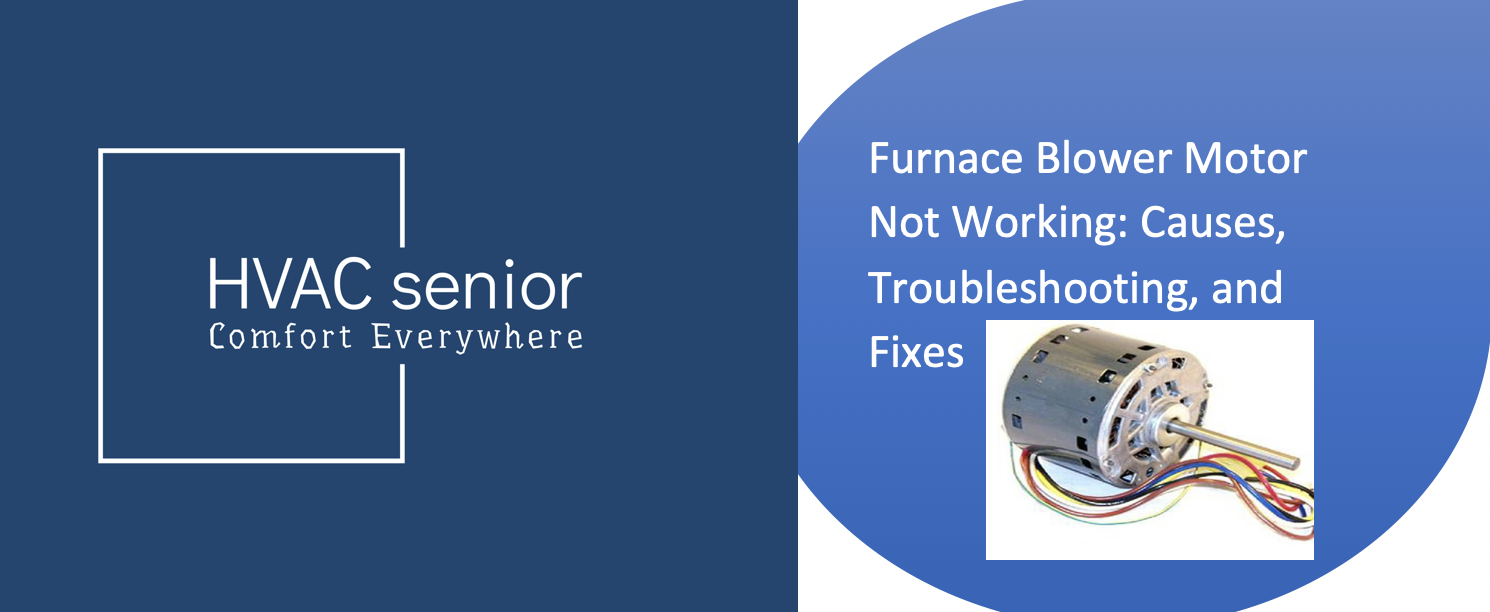When your furnace runs, but no warm air is coming out of the vents, the problem is usually with the blower motor. This is a critical component that circulates the heated air throughout your house. If the furnace blower motor is faulty, your system cannot distribute heat, even if the burners are firing perfectly.
The causes of a blower motor failure can be electrical problems, clogged filters, or worn-out bearings. For this guide, we will go into detail about exactly how you diagnose the problem, perform safe troubleshooting, and decide if a repair or replacement is appropriate.
What is a Furnace Blower Motor?
The blower motor is the heart of the air circulation system in your furnace. Once the burners heat the air inside the heat exchanger, the motor drives a blower fan (squirrel cage) that pushes warm air through your ducts and into the living space.
- Single-Speed Blower Motors – Operate at one constant speed until the desired temperature is reached.
- Variable-Speed or ECM – Electronically Commutated Motor: Automatically adjust speed for greater efficiency, quieter operation, and consistent airflow.
You may experience no airflow or weak airflow, or overheating of the furnace leading to it shutting off much earlier than usual if the blower motor fails.
Common Signs of a Faulty Furnace Blower Motor
Early warning signs help you to take action before complete failure sets in.
- No air flow from vents even though the furnace is on
- Poor or intermittent flow
- Loud humming, rattling, or grinding noises
- Burning smell or electrical odour
- Blower runs continuously or won’t turn on at all
- Furnace shuts off on high limit (overheats)
If you notice any of these symptoms, it is time to inspect the blower motor and related components.
Also read: Mini Split Heat Pump
Why Your Furnace Blower Motor Isn’t Working
Here are the most common reasons your blower motor fails or stops running properly.
1. Circuit Breaker Tripped or Fuse Blown
Electrical overloads or short circuits may have tripped the breaker or blown a fuse, which in turn cuts power to the furnace.
Correct:
Next, check your home’s breaker panel and ensure the furnace switch is ON. If it trips again immediately, you may have a wiring problem or a short in the motor.
2. Dirty Air Filter
Dusty or plugged air filters impede airflow, and thus the blower motor works all that much harder. Consequently, over time, it can overheat and shut down because of thermal overload.
Corrections:
Replace the air filter every 1–3 months. Restricted airflow is one of the easiest — and most common causes of blower problems.
3. Faulty Capacitor
The capacitor is used to store energy for starting and running the blower motor. When it is weak or damaged, the motor may hum but will fail to spin.
Symptoms:
- Blower makes humming noise
- Motor starts slow or does not start at all
- Capacitor seems swollen or leaking
Correct:
Test the capacitor with a multimeter and replace if the reading is below the rated microfarads (μF) on its label. Always discharge the capacitor before handling it.
4. Overheating Motor
Overheating can be caused by dust buildup, poor ventilation, or worn bearings. A common feature of most motors is an internal thermal switch that turns them off when high temperatures are reached.
Fixes:
Let the furnace cool at least 30 minutes. Then, clean dust around the motor and lubricate bearings – if it has them. If these overheating incidents happen more than once, the motor is failing.
Bad Control Board or Relay 5.
When the thermostat calls for heat, the control board sends voltage to the blower motor. If the relay is burnt or if the board is defective, power will not reach the motor.
Corrected:
Check for burn marks, corrosion, or a burnt smell on the control board; replace it if voltage isn’t being sent to the blower terminals.
6. Faulty Thermostat
One other reason could be a faulty thermostat. This would provide incorrect signals, thereby not allowing the blower to turn on or run properly.
Solution:
Check batteries, wiring, and thermostat settings. Put the fan mode to “ON” and see if the blower runs all the time. If not, the problem will be electrical or with the control board.
Also read: Heat Pump Not Working
7. Seized Motor Bearings
Blower motors usually have bearings in them that can wear out over time, especially in an older furnace. Prior to total failure, you may hear squealing or grinding noises.
Corrected:
Try turning the blower wheel by hand (power OFF). If it is stiff or sticky, the bearings have seized, and the motor needs to be replaced.
8. Blower Wheel Clogged
A buildup of dust, lint, and debris on the blower wheel can slow down rotation or throw the wheel off balance.
Fix:
Clean and remove the blower assembly. Compressed air, or a brush, may be used to remove any debris off the blades. Rebalance the wheel before reinstalling.
9. Bad Limit Switch
In the event of an overheat from restricted airflow or dirty coils, a high-limit switch will cut power to the blower as a means of protecting the system.
Fix:
Clean the air filter, see if the vents are blocked, and let the furnace cool down. If the switch repeatedly trips, it could be defective and needs to be replaced.
10. Burnt-Out Blower Motor
Eventually, motors fail due to age, overheating, or electrical wear. When power and capacitor are good but the motor doesn’t run, it may be permanently burned out.
Corrected:
Test the voltage at the motor terminals. If voltage is present but the motor doesn’t spin, a replacement is needed.
How to Troubleshoot a Furnace Blower Motor Not Working
Follow these safe steps before calling a technician.
Step 1: Shutting off Power
Always disconnect power at the breaker or furnace switch to avoid electrical shock.
Step 2: Thermostat Settings
Set your thermostat’s fan mode to “ON”. If the blower does not start, proceed to the next step.
Step 3: Inspect the Breaker and Fuse
Reset the breaker or replace any blown fuses.
Step 4: Replace or Clean the Air Filter
A simple but often overlooked fix to ensure that airflow is immediately restored.
Step 5: Check the Blower Door Switch
It contains a safety switch that prevents the furnace from running unless the blower compartment door is properly closed.
Step 6: Testing the Capacitor
Check the capacitor’s microfarad rating with a multimeter. Replace it if it’s weak or defective.
Step 7: Manually Spin the Blower Wheel
If the wheel does not spin freely, bearings or motor shafts may be seized.
Step 8: Call a Professional
If it’s getting voltage but isn’t running, then it’s time for a replacement or deeper electrical inspection.
Also read: Heat Pump Not Heating
How to Replace a Furnace Blower Motor
Blower Motor Replacement Warning: This procedure involves high voltage and wiring connections. Do not attempt to tackle this project without electrical experience.
Basic Replacement Steps:
- Switch off the power and gas supply.
- Remove the blower compartment cover.
- Disconnect wiring and capacitor leads.
- Unbolt and slide out the blower assembly.
- Remove the old motor and fan wheel.
- Install the new motor, ensuring rotation direction matches.
- Reconnect wires, capacitor, and control board.
- Restore power and test operation.
Blower Motor Replacement Costs
Here’s what to expect when budgeting for repair or replacement:
| Type | Typical Cost (USD) |
| Single-speed motor | $300 – $600 |
| Variable-speed ECM motor | $600 – $1,200 |
| Labor cost | $200 – $400 |
| Full blower assembly | $700 – $1,500 |
While replacement may seem costly, it significantly improves energy efficiency and comfort — particularly with modern ECM motors.
Preventive Maintenance Tips
Proper maintenance prolongs the life of your furnace blower motor and keeps it running smoothly.
- Replace air filters every 1–3 months
- Clean blower wheels annually
- Grease bearings, if appropriate
- Inspect capacitor and wiring during tune-ups
- Schedule annual professional maintenance before winter
- Keep the vents and registers open and unblocked
Preventive care helps your system last longer and maintain peak efficiency.
When to Call a Professional
You should call an HVAC technician if:
- You smell burning or see smoke coming from the furnace
- Blower will not start with proper voltage
- The motor runs briefly then shuts off
- You hear grinding or electrical buzzing
- The furnace repeatedly trips the breaker
Professionals can perform motor diagnostics, replace faulty components, and ensure safe operation.
Conclusion
A nonworking furnace blower motor can make your home cold and uncomfortable, especially during winter. Fortunately, most problems-from a tripped breaker to a bad capacitor-can be diagnosed and even fixed with proper troubleshooting.
If you’ve ruled out simple causes like dirty filters or power issues, it’s best to have a qualified HVAC technician inspect your system.
Timely repair or replacement not only restores heat but also boosts efficiency and extends your furnace’s lifespan. Keep your blower clean, your filters fresh, and be sure to schedule regular maintenance, and your furnace (and your comfort) will thank you.















